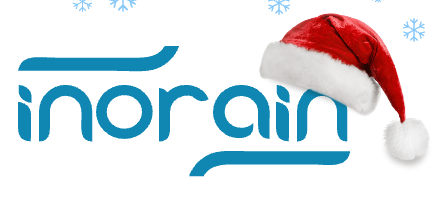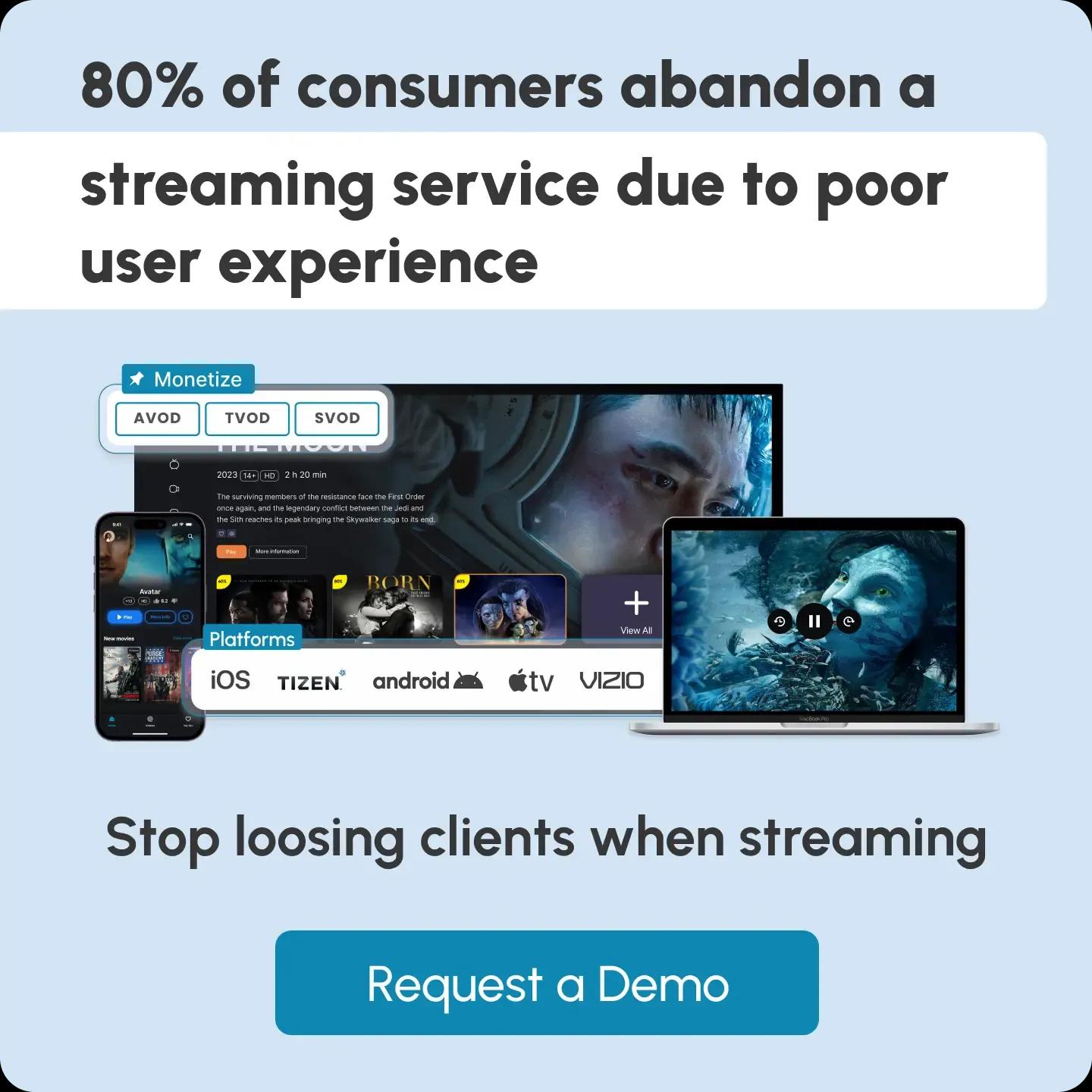Glossary term
BVOD (Broadcast Video on Demand)
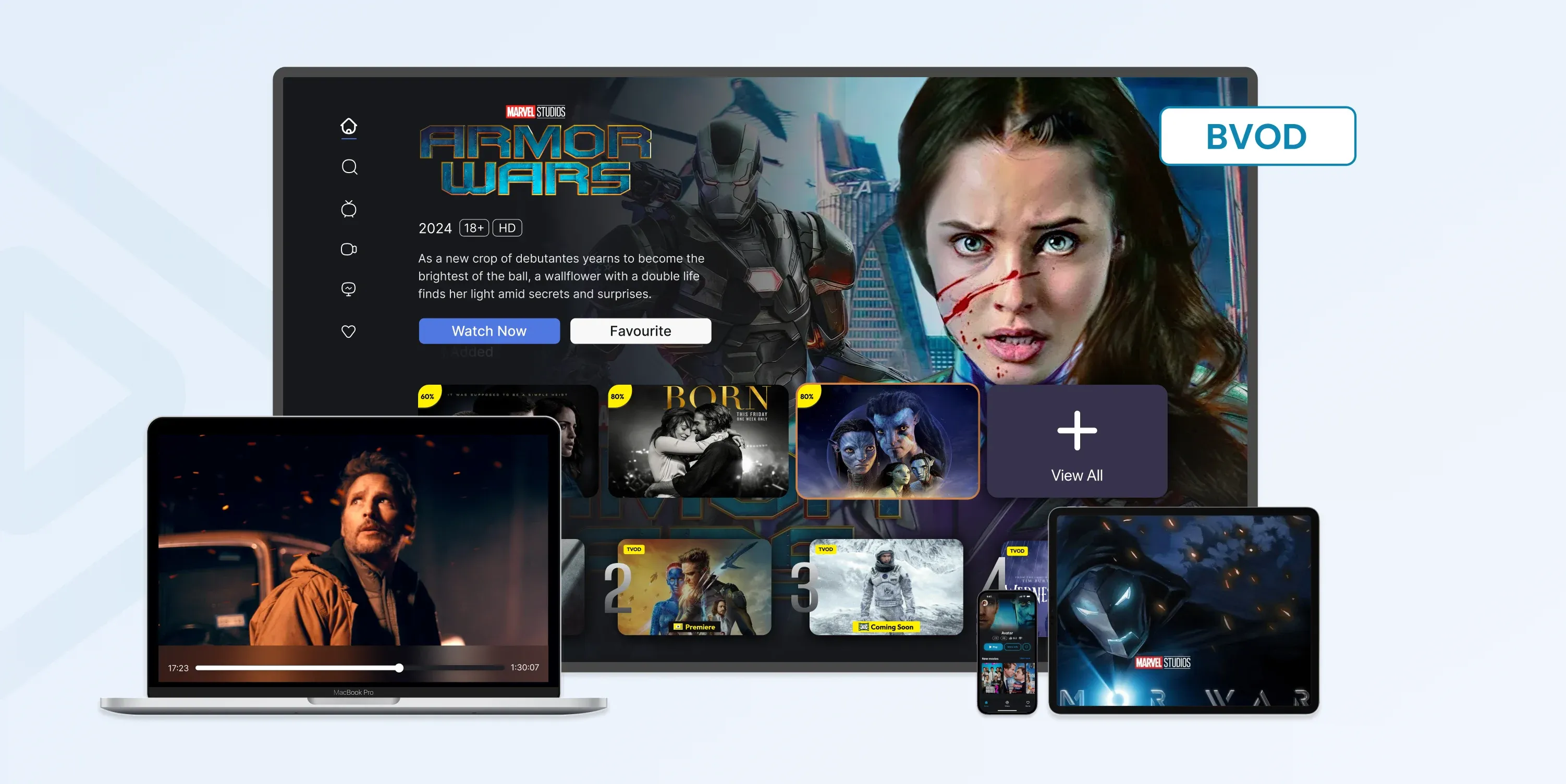
What is BVOD?
BVOD (Broadcast Video on Demand) is a streaming service provided by traditional TV broadcasters (BBC, ITV, Channel 4, or ABC) that allows viewers to watch TV shows, series, movies, and live events online after (or alongside) their original broadcast.
Unlike general VOD platforms (such as Netflix or Amazon Prime), BVOD platforms are directly tied to established TV channels.
Note: BVOD’s purpose was to give traditional broadcasters a way to stay competitive in the streaming era. It offered the same professional content people trust from TV, but with the convenience, personalization, and analytics of digital platforms.
How Does BVOD Work?
BVOD takes traditional TV content, prepares it for digital streaming, and delivers it through apps and websites. Lastly, it supports said content with targeted ads and viewer analytics.
Let’s break everything down into seven steps:
Step 1. Content Broadcast and Upload
Broadcasters air their shows on traditional TV and simultaneously upload them to their BVOD platform. This ensures audiences can access the same trusted programs online.
Step 2. Encoding and Streaming Preparation
The broadcaster’s system encodes the video into multiple versions with different bitrates and resolutions. This makes the content compatible with adaptive streaming, resulting in smooth playback on any device and network condition.
Step 3. Platform Access
Viewers open the broadcaster’s BVOD app or website, where they can browse live streams, catch-up programs, or exclusive digital-only content.
Step 4. Authentication and Personalization
Some BVOD services ask users to sign in or link their TV provider account. This allows the platform to personalize recommendations, apply parental controls, and deliver targeted ads.
Step 5. Ad Insertion and Monetization
Before or during playback, the platform inserts ads—often through Client-Side (CSAI) or Server-Side Ad Insertion (SSAI). These ads can be targeted based on viewer data, making them more effective than linear TV ads.
Step 6. Playback and Engagement
The video streams through adaptive protocols like HLS or MPEG-DASH. The player automatically adjusts quality, ensuring seamless playback across devices.
Step 7. Data Collection and Analytics
The BVOD platform tracks viewing habits like what’s watched, when, how long, and on which device. Broadcasters use this data to improve content, measure success, and refine their advertising strategies.
BVOD in Streaming
BVOD brought an innovation that merged the trust, reach, and quality of traditional broadcast TV with the flexibility of on-demand streaming.
Here’s what made BVOD innovative compared to linear TV and even early VOD:
- Catch-Up Television: Viewers no longer had to watch a show exactly when it aired. They could replay programs on their own schedule, directly from the broadcaster.
- Cross-Device Accessibility: Broadcast content became available not just on TV sets but also on mobile phones, tablets, laptops, and smart TVs.
- Advertising Evolution: BVOD introduced addressable and targeted advertising within trusted broadcast content, combining the reach of TV ads with the precision of digital ads.
- Extended Lifespan of Content: Shows that would usually disappear after a broadcast gained longer relevance, driving additional viewership and revenue streams.
- Stronger Audience Data: Unlike traditional TV ratings, BVOD gave broadcasters granular insights into who was watching, on what device, and at what time.
- Brand Continuity: Broadcasters retained their existing audiences and credibility while competing with global streaming services, creating a hybrid of “old” and “new” media.
Monetization with BVOD
BVOD monetizes primarily through advertising, but its innovation lies in addressable ads, hybrid revenue models, sponsorships, and extended content life. These allow broadcasters to compete with global streaming platforms while maximizing the value of their content.
Here are all the methods BVOD uses to monetize content:
1. Advertising (Primary Model)
Broadcasters monetize BVOD mainly through ads. Unlike linear TV, BVOD enables targeted advertising based on user data such as age, location, device, and viewing history. This makes ads more relevant and valuable. Ads can appear as pre-roll, mid-roll, or post-roll spots, just like in digital video platforms.
2. Addressable Advertising
With BVOD, broadcasters insert ads dynamically so that two viewers watching the same program might see completely different commercials. This addressable advertising blends the reach of television with the precision of digital campaigns, offering higher CPMs (cost per thousand impressions).
3. Hybrid Monetization
Some BVOD services introduce hybrid models. For example, users can watch for free with ads or pay for a premium ad-free experience. This provides broadcasters with two revenue streams—advertising and subscriptions—without losing either audience segment.
4. Sponsorships and Partnerships
Broadcasters also monetize BVOD through branded content, program sponsorships, and strategic partnerships. A brand might sponsor a show’s BVOD release, gaining exposure across both linear and on-demand platforms.
5. Extended Lifespan of Content
Because content stays available after broadcast, BVOD generates additional ad impressions and revenue long after a show’s TV slot has passed. This turns one-time broadcasts into long-tail revenue generators.
6. Data-Driven Value
Monetization improves through analytics. By tracking what viewers watch and when, broadcasters can price their ads more effectively, justify premium rates, and refine campaigns for advertisers.
What are Advantages of BVOD?
Here is a table showing all the benefits that BVOD provides for both users and advertisers.
| Aspect | Benefits for Users | Benefits for Advertisers |
|---|---|---|
| Flexibility | Watch anytime with catch-up and on-demand options | Run campaigns across live + on-demand content |
| Accessibility | Stream on any device, anywhere | Reach viewers beyond the TV screen |
| Cost | Free or low-cost compared to subscriptions | Lower entry costs than traditional broadcast TV ads |
| Content Quality | Trusted broadcaster shows and live channels | Brand-safe environment with premium content |
| Personalization | Tailored recommendations and viewing profiles | Targeted, addressable ads to the right audience |
| Engagement | Replay missed shows and binge at your own pace | Longer ad exposure as shows remain available after broadcast |
| Experience | Consistent quality streaming, often ad-supported | Detailed analytics for campaign performance and optimization |
| Relevance | Content aligned with local culture and region | Access to younger and digital-first audiences |
BVOD in OTT
BVOD platforms (like BBC iPlayer, ITVX, ABC iview, 7plus) are OTT services created by traditional broadcasters. The distribution of shows online through apps and websites is making BVOD a part of OTT.
OTT refers to delivering video content over the internet without relying on traditional cable or satellite distribution. Services like Netflix, Hulu, Disney+, YouTube, and even broadcaster apps fall under OTT.
Learn more about OTT here.
While all BVOD platforms fall under the OTT umbrella, they stand out because they combine the credibility and reach of traditional broadcast TV with the flexibility and personalization of modern streaming. Unlike global OTT services that build audiences purely online, BVOD leverages decades of broadcaster reputation, regulatory trust, and existing content rights. This unique position allows BVOD to deliver a brand-safe environment for advertisers, while offering audiences free, high-quality programming that feels familiar yet accessible across digital devices.
BVOD vs SVOD vs AVOD
BVOD = Broadcasters’ TV content streamed online, mostly free with ads and catch-up options.
SVOD = Paid streaming services offering unlimited, ad-free (or hybrid) access to premium content.
AVOD = Free streaming platforms fully funded by advertising.
Comparison Table
| Aspect | BVOD | SVOD | AVOD |
|---|---|---|---|
| Content Source | TV broadcasters’ shows, catch-up, live streams, and extras | Licensed + original productions | Licensed content, classic titles, mixed catalogs |
| Access Model | Free with ads, sometimes hybrid (ads + subscription) | Paid monthly/annual subscription | Free access, fully ad-supported |
| Main Strength | Trusted broadcaster brand, regional relevance, catch-up convenience | Exclusive originals, global libraries, ad-free tiers | Free access, wide reach, large ad inventory |
| Monetization | Advertising + sometimes subscription upgrades | Subscription fees, sometimes ad tiers | Advertising only |
| Audience Targeting | Based on broadcaster audience data | Based on subscriber profiles and viewing behavior | Based on ad-tech targeting and scale |
| Examples | BBC iPlayer, ITVX, ABC iview | Netflix, Disney+, HBO Max | Pluto TV, Tubi, Freevee |
BVOD Use Cases
Here are some real-life use cases of BVOD that show how broadcasters and viewers actually use it:
Catch-Up TV for Missed Episodes
A viewer misses the latest episode of a popular drama on ITV. Instead of waiting for a rerun, they open ITVX (UK) the next day and watch it instantly, complete with personalized ads.
Live Event Streaming
A sports fan wants to watch a football match but isn’t near a TV. They use BBC iPlayer or 7plus (Australia) on their phone to stream the game live. BVOD lets broadcasters extend live events across all devices.
Regional and Cultural Content
A family in Australia uses ABC iview to access children’s programs and documentaries tailored to their region. Geo-restrictions ensure only licensed audiences get access, while advertisers target local markets.
Hybrid Monetization
A viewer watches free episodes with ads on ITVX, but decides to upgrade to the paid “Premium” plan to skip ads and unlock extra shows. This hybrid model lets broadcasters earn from both ads and subscriptions.
Exclusive Digital Content
Channel 4’s All 4 (UK) offers behind-the-scenes clips and web-only shorts that never aired on linear TV. Viewers engage with the brand beyond broadcast, while advertisers sponsor bonus content.
Addressable Advertising
Two viewers stream the same show on BBC iPlayer—one sees a car ad, the other sees a travel ad. BVOD dynamically replaces commercials to match each person’s profile, creating more effective ad spend.
Long-Tail Revenue from Old Shows
Broadcasters upload classic series to their BVOD platforms. Viewers binge-watch old episodes years later, generating fresh ad revenue long after the original broadcast.
Frequently Asked Questions
Content Writer
Anush Sargsyan is a content writer specializing in B2B content about OTT streaming technologies and digital media innovation. She creates informative, engaging content on video delivery, OTT monetization, and modern media technologies. The goal is to help readers easily understand complex ideas. Her writing is the bridge between technical detail and practical insight, making advanced concepts accessible for both industry professionals and general audiences.
Related terms
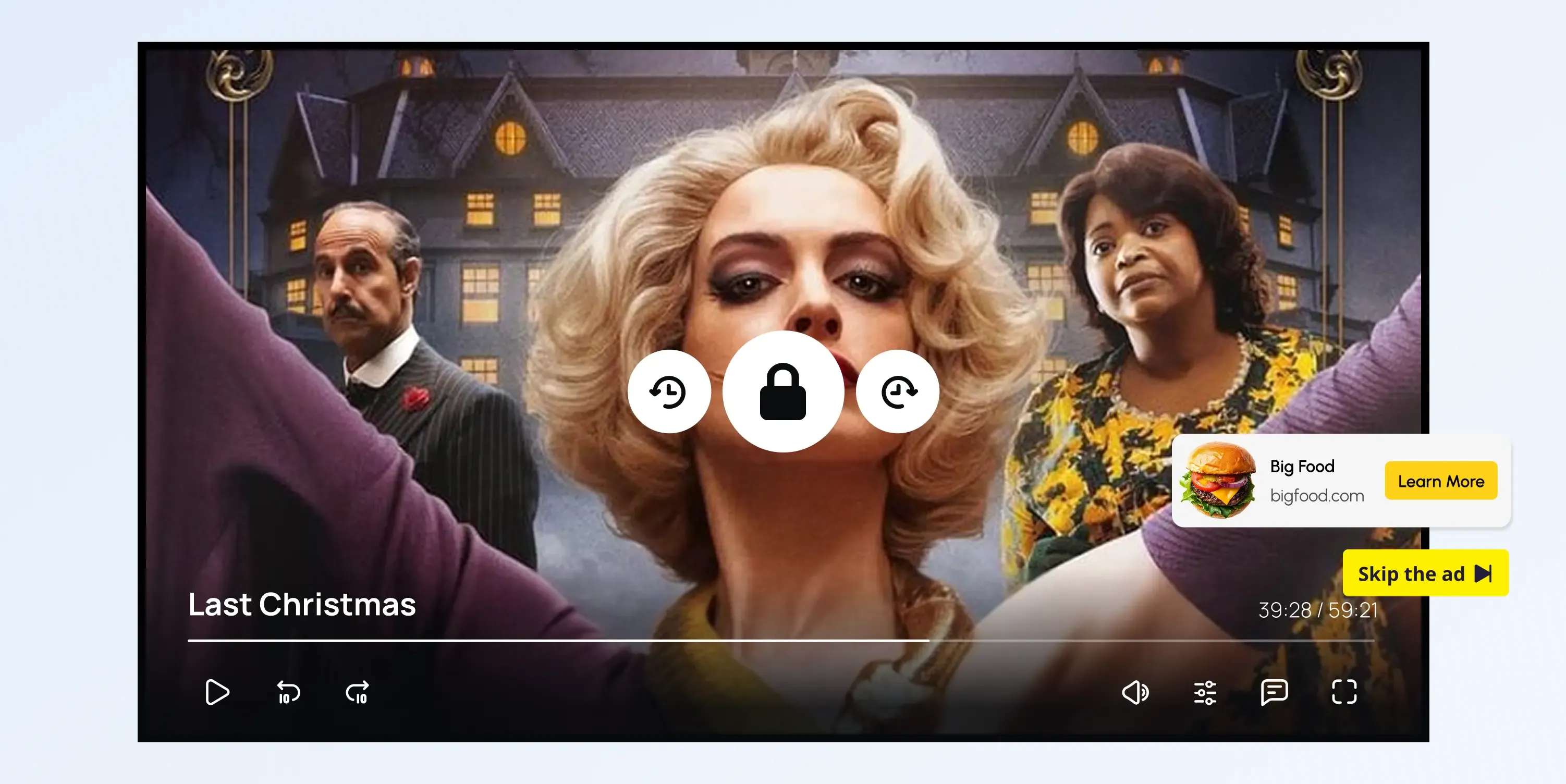
AVOD (Advertising-Based Video on Demand)
Explore how AVOD works, its monetization model, and why it's popular for free streaming platforms. Read the full definition on inorain.com glossary.
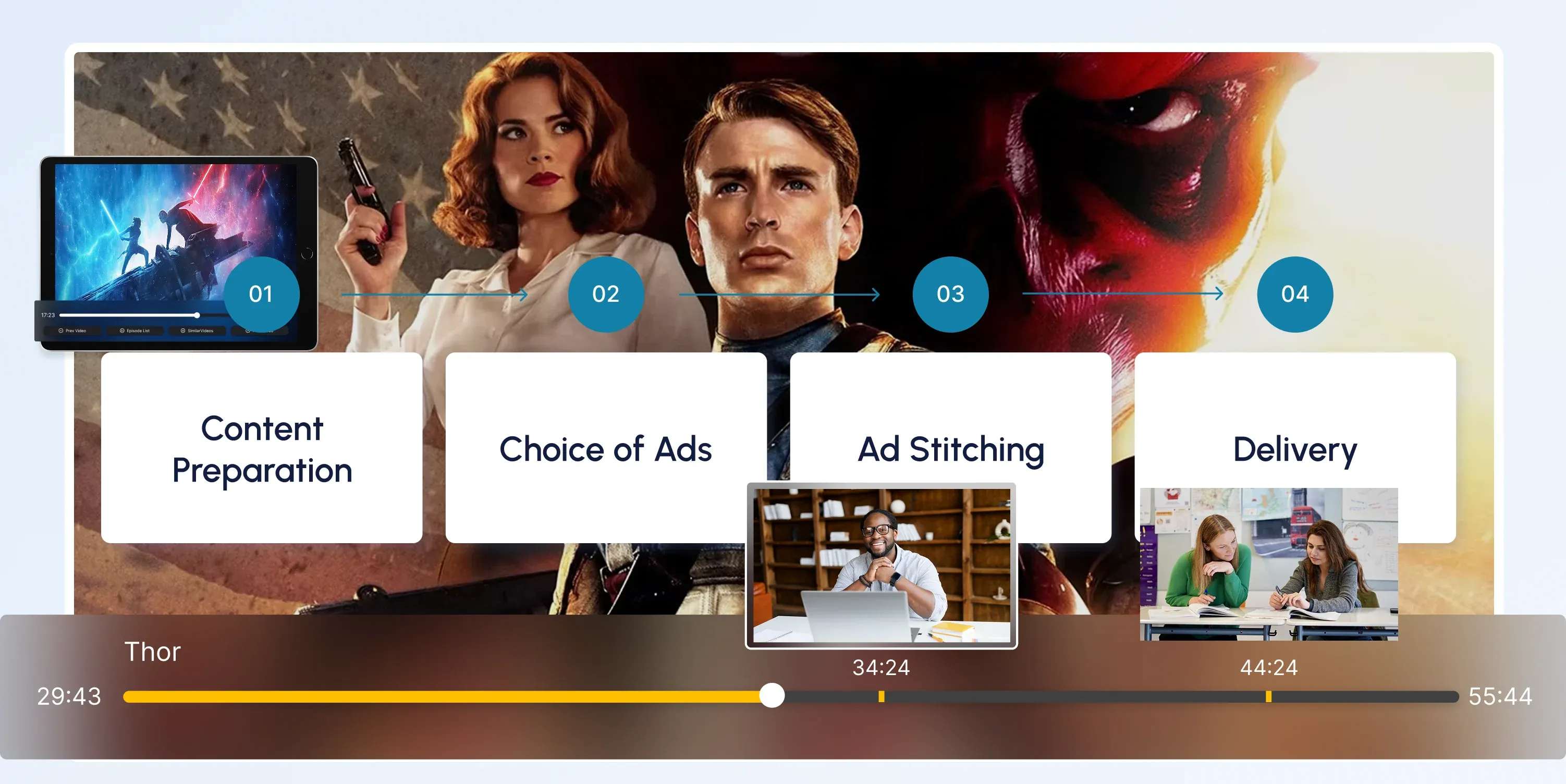
CSAI (Client-Side Ad Insertion)
Learn how CSAI delivers ads through the video player, enabling targeting, tracking, and monetization.
